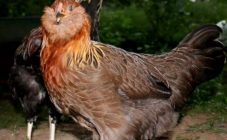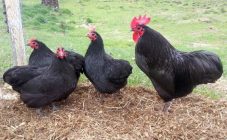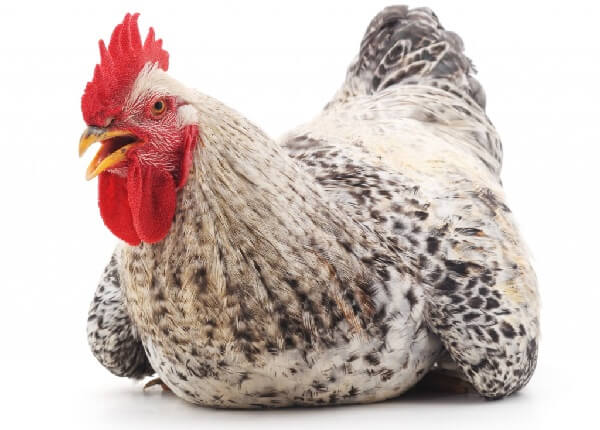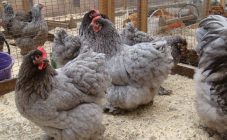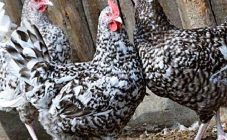Content:
From time immemorial, chicken has been an integral part in any backyard, both in the village and in urban areas. In some countries, such as France, Kenya, Switzerland, some states of the United States, the rooster or chicken is considered the national bird, albeit unofficially. There are a lot of fairy tales and proverbs involving a chicken. This speaks of universal love and gratitude for this bird. There are several hundred types of chickens in the world.
A bit of history
It is believed that the chicken was domesticated about 6-8 thousand years ago. The ancestors of the bird are from Southeast Asia.
At first, these birds were bred for the sake of entertainment - cockfighting. Later, man tasted both meat and a very valuable product - an egg. Keeping chickens at home is not difficult, especially if it is possible to provide them with free range.
Types of chickens
There are five directions of varieties of chickens:
- Meat. Grown for meat, their weight reaches 4-5 kg. They move less than their egg counterparts, therefore, spend less energy and build more muscle tissue;
- Meat products. These are universal chickens, they get both an egg and meat. In constitution, they are smaller than chickens of the meat direction, but larger than the egg;
- Egg chickens are small in size, high mobility and increased egg production;
- Fighting. This breed is the oldest. Chickens can vary in weight (from 500 g to 5 kg), but all are united by aggressiveness and strong constitution;
- Decorative. These breeds of chickens have low productivity, but a very beautiful and unusual look.
There are several subspecies of chickens with a tufted head:
- Russian crested calico. The Calico Corydalis was bred in 1995 by crossing the Leningrad Calico breed and the Palevoy Russian Corydalis.
- Tsarskoye Selo Corydalis. This chicken was also bred in 1995 at the VNIIGZh Experimental Farm by crossing a rooster of the Tsarskoye Selo breed with the Paleva Russian Corydalis.
- Ukrainian Chubataya. The homeland of this ancient chicken is Ukraine. This is a representative of the meat-eating breed.
- Pavlovskaya. At the end of the 19th century, another crested chicken was bred in the Nizhny Novgorod province, it was named after the village of Pavlovo, where it was bred. This real beauty with a silver or golden color with black splashes lays large eggs up to 62 g.
- Dutch white-crested. It was bred in Holland in the 15th century, but later breeders "added" the blood of Polish breeds to it and got a beauty with a white tuft, which looks charming in combination with black plumage.
This is only a small part of the names of chickens with a tufted head.
Russian crested breed of chickens
Russian farmers brought it out more than a hundred years ago. But there is also a version that the crested chicken appeared in Asia. Many scientists are leaning towards Russian origin.
Chickens can rightfully be called decorative due to their beauty, but they are still meat-eating direction. Such a chicken brings more than 160 eggs per year. The color of the eggs is cream or white, weight 50-56 g. In these hens, puberty begins early, they begin to lay at the age of 5-6 months. Gradually, egg production decreases and the hen is put under the knife. Get 2-2.2 kilograms of tasty meat.
Description
Outwardly, this chicken cannot be confused with any other breed of chicken. She has a characteristic "cap" - a crest on her head. It is worth noting that in females this hat is much larger than that of males.
Chickens with a wide, dense, elongated body, straight flat back, with a normally developed belly and a slightly elongated head shape will adorn any chicken coop. The skin has a pleasant pink color, while the earrings are deep red. The beak is strong, slightly bent at the end (owners of a different beak shape are threatened with culling). The color of the eyes is orange, sometimes red, the crest of a small size is completely hidden under the tuft. The color of the abundant, tight-fitting plumage is varied:
- Blue;
- Sitsev;
- Gray;
- Black;
- Red;
- Lososev;
- Black and gold;
- Black and silver;
- Cuckoo;
- White.
Crested roosters differ little from females. They are slightly larger, the crest on the head of the cockerels is smaller, the wingspan is larger, the shape of the tail is different. These are, perhaps, all the differences.
Chickens are well fertilized, they have a very well developed instinct for incubation and motherhood.
A rooster with a tuft and the same hen, of course, will have the offspring with the same characteristics. Chickens look very beautiful, with a small forelock on their heads, fluffy nimble lumps. Chicks are very gluttonous from the first days, and therefore grow at a rapid pace. In the early days, their food consists mainly of boiled eggs, cottage cheese and finely ground cereals, finely chopped greens. Then you can add dry feed, mash, everything like in adult chickens, only crushed. Throughout the entire time of growing up, chickens need protein foods and vitamins.
Advantages and disadvantages
The Russian Crested Chicken has many advantages:
- It tolerates cold well;
- Cute luxurious chicken;
- Delicacy meat;
- Various colors;
- Good egg production;
- High survival rate;
- The chickens have a peaceful nature;
- Unpretentious in content.
The disadvantages include only the fact that the males are very hostile to each other.
Breeding
Crested chickens are loved by many poultry breeders. This breed is unpretentious to living conditions, is not afraid of either cold winters, or rainy or hot summers. Yet heredity makes itself felt. After all, initially Ukrainians lived without any "conveniences": without heating, additional lighting, and food was very scarce.
In modern chicken coops with ventilation, perches and quality bedding, hens feel great.
Chicken chickens are very unpretentious in food. In summer, free-range, they find their own food. Very little additional food is required, drinkers with clean water must be present. In winter, a little more care is required. They will need to additionally prepare a mash of dried herbs, vegetables, cereals, and corn. It is useful to feed the bird special feed mixtures for chickens.
It is necessary that calcium is present in the diet of chickens - eggshell, chalk, shell. And you also need additional containers with gravel or sand for better grinding food in the stomach.
Diseases
These feathered individuals have immunity in the same line as wild birds - very resistant to various diseases. Therefore, if the hen house is clean and tidy, as well as constant ventilation, these birds are not afraid of diseases. For the sake of prevention, chamomile broth can be added to drinking water.
To prevent parasites from growing in the feathers, a trough of ash must be placed in the chicken coop. Chickens will take "baths" and they will not be afraid of puffy eaters. Another problem with increased productivity and insufficient vitamin intake is baldness. To prevent this from happening, the bird needs to be given ground egg shells, to replenish the deficiency of vitamin D. Baldness also occurs during natural molting. In such cases, it is necessary to increase the amount of nutrition so that the feathers recover sooner.



